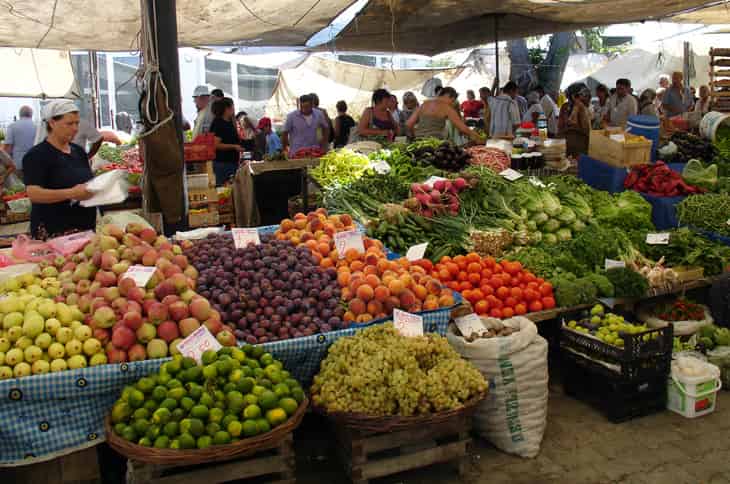Report: Economic Indicators of Turkey – January 2012
CBRT announced the Monetary and Foreign Exchange Policy for 2012 on December 27th and gave significant messages regarding the policies to be implemented in the coming period. It was stated that the flexibility in monetary policy would be kept due to the high level of uncertainties about the course of global economy and the excess volatility in risk appetite. Besides, CBRT’s steps to enhance its communication strategy in order to increase the predictability were welcomed by the markets. In order to contain the current inflationary pressures, CBRT further tightened the monetary policy on December 29th, in parallel with the newly announced Monetary and Exchange Rate Policy for 2012.
GROWTH
Despite the measures taken by the policy makers, Turkish economy grew by 8.2% in the third quarter, well above the expectations.
According to the Reuters’ survey,markets expected a growth rate of 7%. In addition to that, first quarter growth figure was also revised from 11.6% to 12%. Thus, Turkey grew by 9.6% in the first three quarters of 2011 compared to the same period of 2010.
Source: Turkstat
Slowdown in private consumption and investment expenditures…
According to the GDP figures by expenditures approach, it was seen that private consumption and investment expenditures, which made the highest contribution to growth throughout the year, lost momentum recently. In the third quarter of the year, private consumption and investment expenditures contributed to growth by 4.7 and 3.1 points, respectively. In addition to that, parallel to the policies aiming to control economic activity, the rise in imports lost pace and net exports made a positive contribution to the growth for the first time since the third quarter of 2009.
These figures suggest that rebalancing between the domestic and external demand is ongoing as CBRT envisaged.
In line with the “remarkable” tightening measures taken by CBRT and other authorities aiming to control the domestic economic activity in the last quarter, the annual increase in credit volume lost momentum. In the coming period, these policies are also expected to slow down the rise in private consumption and investment expenditures, which made the highest contribution to growth aftermath the crisis, and lead to a decline in economic growth rate. On the other hand, net exports are anticipated to support the growth. Leading indicators regarding the last quarter of 2011 showed that economic growth continued albeit at a slower pace.
In this context, we estimate the Turkish economy, which displayed a strong growth performance in the first three quarters of the year, to have grown by 8.3% in 2011. In 2012, on the other hand, due to the tightening measures taken by CBRT and the lagged effects of the slowdown in the Euro Area, Turkey’s main export destination, economic outlook is subject to downside risks. Due to the mentioned factors, we foresee growth rate would slow down to 3.5% in 2012.
Leading indicators in December pointed out a slowdown in domestic economic activity.
Recent data releases have revealed that the adverse effects of developments in global markets on Turkish economy have become more evident since October.
Although, consumer confidence index increased by 1.3 points to 91 in November, real sector’s expectations about Turkish economy have become a bit more pessimistic as shown by the real sector confidence index declining to 97.2, the lowest level in the post crisis period. Still below the pre-crisis levels, capacity utilization ratio (CUR) has decreased significantly to 75.5% in December, the lowest level of the last 5 months. On the other hand, seasonally adjusted CUR which has been rising since July 2011, has increased by 1 point to 76.6%.
The lowest unemployment rate since 2001
According to the Household Labor Force Survey, in September the unemployment rate fell by 2.5 points to 8.8%, the lowest level since 2001. In the same period, seasonal adjusted unemployment rate declined to 9.2%. During the last one year period, the number of employed persons in Turkey increased by 1,776 thousands to 24,749 thousands. In this period, 40% of the employment growth came from the services sector and 27% from the agricultural sector. In addition, employment increase in construction sector, which displayed a rapid growth in post-crisis period, was also remarkable.
Leading indicators in December pointed out a slowdown in domestic economic activity.
In November, foreign trade deficit narrowed
In November, compared to the same month of the previous year, exports and imports increased by 18.5% and 8.8%, respectively. In line with the ongoing deceleration in domestic demand, annual change in imports decreased to the lowest level of the last two years and the monthly foreign trade deficit has decreased for the first time since October 2009. Looking at the cumulative figures, in the first eleven months, foreign trade deficit widened by 55% compared to the same period of 2010 while imports coverage ratio was realized as 55.6%.
Rapid rise in exports
In November, high annual increases were observed in exports of pearls, precious stones and metals, motor vehicles, and iron and steel subgroups. On the otherhand, compared to the same period of the previous year, decrease in the exports of knitted and non-knitted goods was noeworthy.
Contraction in imports of capital and consumption goods…
As a result of weakening domestic demand, the increase in imports continued to decelerate in November. Compared to the same month of the previous year, imports of intermediate goods increased by 16.9%, while imports of capital and consumption goods decreased by 8.3% and 6.2%, respectively. Consumption goods imports decreased for the first time since September 2009 mainly due to the 15% fall in automobile imports.
Rapid rise in exports…
In recent months, effects of the rebalancing between domestic and external demand on the foreign trade figures have started to become more evident. Depending on the course of the domestic demand, contraction in foreign trade deficit is expected to continue in the coming months. During 2012, the developments in EU which is the Turkey’s largest export market and the Middle East and North Africa, the alternative export destinations, are thought to be effective on the course of the foreign trade balance.
In October, current account deficit was realized below expectations.
In October, current account deficit was realized below market expectations and narrowed to $4.2 billion compared to the previous month. Contraction in the trade deficit as well as relatively good performance in services balance due to the contribution of tourism and transportation sectors were effective in lower than expected current account deficit. Thus, the current account deficit increased to $65.1 billion in the first 10 months of the year, and to $78.6 billion on a 12-month cumulative basis.
Current account deficit was financed by CBRT reserves to a considerable extent
In October, net foreign direct investments displayed a weaker outlook and remained at only $317 million, while in equity markets foreign capital outflows were observed and total outflow in this market approached to $1 billion in the first ten months of the year. In October, $1.3 billion of capital inflows were registered in debt securities, the majority of which was the Government’s $1 billion of Eurobond auction held abroad.
On the other hand, ongoing high levels of debt rollover ratios in both banking and non-bank sectors indicate that the problems in foreign markets have not yet been reflected on the external financing channel. In October, the net errors and omissions continued to play a role in the financing of the current account deficit. On the other hand, $3.7 billion decline in official reserves to finance the current account deficit was noteworthy.
Analyzing the foreign capital flows for the first ten months of the year, it was seen that $9.8 billion of direct investment, $15.5 billion of portfolio investment, $17.9 billion increase in foreign liabilities, $10.5 billion use of residents’ foreign currency assets, $13.1 billion of net errors and omissions were realized, indicating $66.8 billion of total capital inflow to Turkey.
Effects of the developments in global economy on the supply of foreign loans will be watched
In the coming months, contraction in the foreign trade deficit is expected to contribute more to the decline in current account deficit. In 2012, the banking sector and real sector loans raised from abroad are expected to continue to play an important role in financing the current account deficit. On the other hand, possibility of a sudden stop in capital flows depending on international developments is one of the most important risks which may lead economic growth to slow down more than expected.
Budget continued to yield surplus in November
Central government budget posted a surplus of TL2.1 billion in November. Primary surplus also reached TL5.7 billion increasing by 22.4% compared to the same month of previous year. Consequently, during the first 11 months of 2011, budget posted a surplus despite the year-end target (which claimed a deficit); and the primary surplus of TL41.4 almost tripled the target.
Tax revenues already surpassed its year-end target.
In November, budget revenues performed a favourable outlook as a result of 17.2% increase in tax revenues, whereas other revenues declined compared to the same month of previous year. Rise in tax revenues stemmed mainly from the increase in income tax, corporate tax and private consumption tax on tobacco products. VAT on imports also rose 19.9% compared to the same period of previous year; however the annual increase in this tax lost pace lately. This actually confirms a relative slowdown in the pace of rise in imports. As of the first 11 months, we observe that tax revenues have already surpassed the year-end target thanks to strong economic activity and restructuring of the public claims; thus budget revenues also converged to its year-end target.
Controlling budget expenditures during the period of strong economic activity is likely to support the economy during tough times.
Budget figures demonstrate a positive trend on the revenues side and we observe that the fiscal discipline has been kept on the expenditures side. In November, interest expenditures declined by 29.6% compared to the same month of previous year, and it already reached 86.3% of its year-end target in the first 11 months.
Furthermore, the rise in non-interest expenditures lagged behind the increase in budget revenues. As a result, rise in budget expenditures was realized at only 6.5% during the January-November 2011 compared to the same period of previous year. Maintaining budget discipline throughout 2011 gives policy makers more room to act more flexibly in case of a slowdown in economic activity. Additionally, in an environment where many countries are struggling with the high public debts and budget deficit problems, tight fiscal policies would differentiate Turkey positively from other countries and affect the country’s cost of borrowing positively.
CBRT announced the Monetary and Foreign Exchange Policy for 2012
CBRT announced the Monetary and Foreign Exchange Policy for 2012 on December 27th and gave significant messages regarding the policies to be implemented in the coming period. It was stated that the flexibility in monetary policy would be kept due to the high level of uncertainties about the course of global economy and excess volatility in risk appetite. Besides, CBRT’s steps to enhance its communication strategy in order to increase the predictability were welcomed by the markets.
It was stated that inflation target would be 5% for the next 3 years. CBRT explained that the developments in FX and commodity prices added 500 basis points to the 2011 year-end inflation while the price adjustments in products having administered prices put an additional 160 basis points. It was stressed that the inflation would converge to 5% year-end target through the end of 2012 once these effects fade away. In order to contain the current inflationary pressures, CBRT further tightened the Monetary Policy on December 29th, in parallel with the newly announced Monetary and Exchange Rate Policy for 2012.
The most remarkable point in CBRT’s statements regarding its monetary and foreign exchange policy for 2012 has been the decision to define “normal days” and “exceptional days” and implement different FX policy and liquidity policy according to the type of the day. In this context, it was announced that CBRT would provide TL liquidity to the market via quantity auction method with the policy rate of 5.75% while meeting up to $50 million of the bids in the FX selling auctions in normal days.
During the exceptional days, CBRT would make additional tightening and would not supply liquidity at policy rates. Instead, the markets would be funded via traditional auction method with higher costs. In addition to that, CBRT declared it would supply more than $50 million into FX markets in exceptional days and might intervene in markets directly by selling FX when deemed necessary.
In the last days of December, while CBRT’s tightening policies became more evident, banks’ funding costs increased accordingly. In addition to that, CBRT’s interventions in FX markets also intensified. In the last two days of the month, CBRT sold nearly $3 billion while this intervention had a limited effect on $/TL parity.
We expect CBRT to continue its tight monetary stance for a while.
After having tightened monetary policy further at the end of 2011, we expect that the CBRT would continue to take its price stability mandate in the forefont for a while.
We anticipate that headline inflation would stay close to double-digit levels until May 2012 and later decline to single-digit levels in the remaining part of the year. We think that the reflections of the developments in global markets on both FX rates and inflation outlook would be influential on the course of CBRT’s policies.
BANKING SECTOR
Deposit volume increased by 13% compared to the year-end
According to BRSA’s Weekly Bulletin, as of December 23rd, total deposits volume increased by 13% compared to the previous year-end. During the same period, increase in TL deposits was only 4.7% while FX deposits in terms of TL rose by 31.8%. FX deposits in terms of USD increased by 8%, on the other hand. The increase in deposits has been slower compared to the previous years mainly due to the increase in investment and consumption expenditures as well as the reserve requirement arrangements made during 2011. The banking sector continued to seek alternative funding instruments throughout 2011.
Exchange rate adjusted credit volume increasedby 21.5%
As of December 23rd, 2011, total credit volume increased by 28.3% compared to the previous year-end. When adjusted for the exchange rate, the increase in credit volume receded to 21.5%. In this period, FX loans in USD terms rose by 13.9% while TL loans increased by 24.3%.It was seen that the increase in FX loans in USD terms has been significantly lower due to the high volatility in FX rates.
Source: BRSA Weekly Bulletin
Securities portfolio…
As of December 23rd, 2011, banks’ securities portfolio decreased by 0.3% compared to the previous year-end. TL securities declined by 2.6% while FX securities rose by 12.3% parallel to the rise in FX rates.
Securities portfolio held in custody accounts
As of December 23rd, 2011, securities portfolio held in custody accounts increased by 27.7% to TL163.4 billion compared to the previous year-end. In this period, nonresidents expanded their portfolio by 67.1% while residents’ portfolio increased by
only 9.4%.
Net FX position of the banking sector was realized as (+) $723 million
As of December 23rd, 2011, net FX position of the banking sector was realized as (+) $723 million. Banks’ on-balance sheet FX position was (-) $20,700 million while off-balance sheet FX position was (+) $21,422 million.
Expectations…
The risks to global economy, mainly stemming from the Euro Area, are expected to persist during 2012. In this context, despite the comparative advantage in exports coming from the rise in FX rates, external demand is not anticipated to recover quickly in 2012. CBRT, after having further tightened the monetary policy to contain the secondary effects of the rise in inflation, is expected to keep its stance for a while. In addition, due to the fact that the domestic demand will increase only gradually, it is anticipated that the real economic growth will slow down and the credit volume will increase at a more moderate pace in 2012 compared to 2011.
compiled by Editor, BTT
SOURCE. ISBANK.COM.TR





